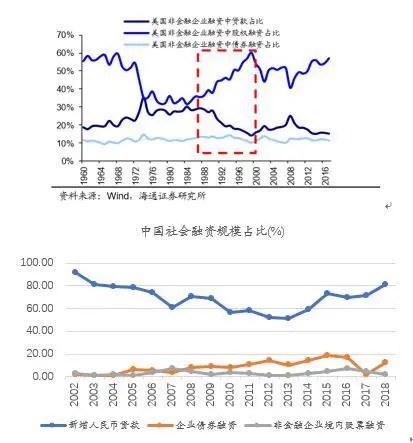2019.04.30 Source: Shenzhen Special Zone Daily Views:
During the CoStone Capital Annual Conference on April 28th, Chairman Zhang Wei stated that China's upcoming Science and Technology Innovation Board (STIB) will serve as another great practice of China's strategy of asymmetric competition in the financial market. This strategy is similar to China's industrial policies from 2000 to 2010 when the Chinese government selectively supported domestic telecommunications operators and equipment manufacturers, such as Huawei, in their competition against companies like Cisco. It was in this context that Huawei emerged in China.
Zhang Wei believes that both the development of a nation and its enterprises have standard answers. Regarding competition between nations, the economic strength and vitality of the United States, for instance, are closely related to its highly developed system of direct financing. For example, the number of effective intellectual property rights owned by the United States is similar to that of the European Union, but the sales revenue of high-tech industries in the United States is four times greater than that of the EU. The difference lies in the fact that the financing system driven by capital markets greatly facilitates innovation and entrepreneurship throughout society, whereas a financing system dominated by banks has the opposite effect. Behind this difference lies the monumental role played by NASDAQ. China is currently launching the STIB, and the timing is opportune. The STIB will be the engine for China's next round of innovation in the economy.
"Asymmetric competition refers to the competition in a market featuring asymmetrical limitations and incentives, whereby companies with vastly different strengths compete in unequal or different ways. This competition seeks to answer an increasingly important and urgent question: should small and disadvantaged local companies, operating under the background of economic globalization, market openness, and the trend of monopolistic concentration in various industries, strive to grow? And if so, how?" said Zhang Wei.
The STIB will be the engine for China's next round of innovation economy.
As an investor who has been actively involved in the venture capital industry for the past 18 years, Zhang Wei has deep insight into the environment for the development of Chinese technology enterprises. From the perspective of the relationship between the financial market and innovation, China primarily relies on indirect financing through bank loans, with a low proportion of direct financing. Direct financing accounts for about 20% in China, while in the United States, it accounts for approximately 70% to 80%. Thus, China's level of direct financing lags far behind that of the United States.
Innovation is highly correlated with direct financing, with the equity market being the most crucial component of direct financing. Professor Tian Xuan from Tsinghua University has found through research that the development of the equity market can promote innovation for enterprises with a high degree of external financing reliance, while the development of the credit market hinders innovation. For high-tech intensive industries, the development of the equity market can foster innovation for enterprises, while the credit market has the opposite effect. The conclusion is that there is a positive correlation between innovative patents and the development of the equity market, and a negative correlation with the development of the credit market.

China's level of direct financing accounts for about 20%, significantly lower than the 70%-80% in the United States. Bank loans remain the primary means of financing.
The STIB of the Shanghai Stock Exchange focuses on supporting industries such as the new generation of information technology, high-end equipment, new materials, new energy, energy conservation and environmental protection, and biomedicine. It aims to promote the deep integration of the internet, big data, cloud computing, artificial intelligence, and manufacturing industry. Currently, apart from a few areas such as the internet, artificial intelligence, big data, and new energy batteries, where the development stage between China and the United States is relatively close, the majority of the technology sectors supported by the STIB are traditional tech fields in which China lags far behind the West. In these traditional hard-tech sectors with huge gaps between China and the West, it has been quite difficult to:
- Obtain loan support from banks;
- List domestically due to a lack of scale and profitability, leading to a lack of active investment from most institutions;
- Gain recognition from overseas capital markets when listing abroad due to a vast disparity in size compared to mature market competitors, resulting in no valuation premium or liquidity and making it nearly impossible to truly raise funds.
With the introduction of the STIB, it will:
- Directly expand the investment boundaries and tolerance of arbitrage institutions in the market, greatly enhancing the direct financing capability for original and innovative technology companies, thereby accelerating the development of original hard-tech in China;
- Effectively guide domestic institutions, especially RMB funds, to actively invest in smaller and more dynamic SMEs;
- The registration-based system reform contributes to increasing the financing scale and improving the support efficiency for SMEs in the capital market;
- Require enterprises to enhance their own original technological capabilities.
The STIB and the registration-based system'slaunch will help alleviate the enormous financial pressure faced by domestic technology companies in their early stages of development and extend the survival period for these enterprises.
NASDAQ's assistance in helping the United States win the US-Japan trade war
Looking at the competition between the United States and Japan further reinforces this point. In the 1970s and 1980s, when it seemed that Japan's economy would surpass that of the United States, the key factor that allowed the United States to surpass Japan was the economic transformation brought about by the development of internet technology. NASDAQ played a crucial role in this transformation by channeling funds into the technology industry, while Japan made serious mistakes in its financial industry policies. Following the Plaza Accord, the burst of the real estate bubble, and the double blow of the trade conflict, Japan's economy was completely knocked down.
In comparison, NASDAQ actively supported small businesses when it was established, and it mutually supported Silicon Valley. This solidified the United States' significant advantage in the field of technology in the new era. On one hand, NASDAQ directed capital into high-tech sectors. Starting from the 1980s, significant breakthroughs were achieved in genetic engineering, the pharmaceutical industry, biotechnology, computers, and telecommunications, among other fields. The rapid development of scientific and technological advancements presented a ripe opportunity, which the agile venture capital industry in the United States captured, investing in high-tech sectors. NASDAQ provided the institutional framework for exiting from venture capital investments. Additionally, NASDAQ offered financial support to small and medium-sized enterprises, effectively encouraging technological innovations.
On the other hand, high technology became a new source of economic growth and promoted the upgrading of traditional industries. The high-tech industry in the United States propelled the country into its longest period of continuous economic growth since World War II. High technology facilitated industrial upgrading, leading not only to increasing output value year after year but also to the informationization and high-tech transformation of traditional industries. It became a new growth point of the US economy and a pillar industry. Consequently, the US economic growth relied on an information industry foundation. The formation and development of the information industry played a critical role in the prosperity and stability of the US economy, acting as the fundamental driving force behind the "new economic structure."

NASDAQ-listed companies such as Microsoft, Apple, and Amazon are enormously wealthy, with market values exceeding twice the GDP of Israel.
Actually, the competition between the United States and Japan provides further evidence. In the 1970s and 1980s, as Japan's economy seemed poised to surpass that of the United States, the game-changer that allowed the United States to pull ahead was the economic transformation brought about by the development of internet technology. In this regard, the Nasdaq played a crucial role by channeling funds into the technology industry. On the other hand, Japan suffered severe policy mistakes in the financial industry. Following the Plaza Accord, Japan faced the dual blow of a burst real estate bubble and trade conflicts, which ultimately dealt a devastating blow to its economy.
The year 2019 marks the fortieth anniversary of China’s Reform &Opening-Up, once again, we meet at the turning point of history. What’s the next step for the game, is there any clear guidance? The answer is affirmative.
Our country is enjoying a good momentum of development, which does not come from the Washington Consensus nor the Beijing Consensus. China’s experience has proved that both the visible hand and the invisible hand are crucial: the visible hand, stands for the government-led reform, and would yield benefits for reform and opening up; the invisible hand, stands for the Marginal Power represented by the private sector, and would improve economic efficiency and tax collection, create jobs and employment opportunities.
Provided that we want to protect and expand the benefits form reform, three simple but mandatory agreements are to be made and followed: No.1 Private ownership must be recognized, protected and treated equally with public ownership constitutionally, both ownerships are scared and inviolable;No.2 Make further clarification of the principal position of market economy, “deepen economic system reform by centering on the decisive role of the market in allocating resources”, as President Xi addressed in the third Plenary Session of the 18th CPC Central Committee;No.3 Implement the guiding principles of “comprehensively promoting law-based governance” of the fourth plenum. The rule of law is essential for economic growth, irreplaceable to protect private ownership, and necessary to encourage innovation and entrepreneurship.
Above are three rules for us to avoid falling into the Middle-income Trap. Assuming that we are breaking systematic barriers to private enterprises’ participation in market economy, and boosting innovation and entrepreneurship of our society, then we are heading towards a promoting direction. We are marching in the path of light, regardless of the ups and downs of Sino-US relationship, the drop in GDP growth rate, or the monetary policy.
These principals also apply on knowing how better to run a business: don’t be hedged by rules and regulations at the beginning, pay more attention to your survival, and you’ll learn more when you start your second business.
For many years, Huawei has been the only Chinese company on the list of the Top 50 R&D Spenders. Regardless of the economy and its income, what Huawei has been doing is investing in its future, dedicated to R&D, continuously and resolutely. This provisional work underscores Huawei’s accomplishments, making Huawei anindustry leader.
So, there are standard answers on how to run a company,which could be summarized as concentration and professional dedication, continuous investment on innovation and trying harder in R&D. Entrepreneurship is also important, every single company needs entrepreneurs to push aside all obstacles and difficulties, to implement strategies and ideas. We, as investors, are destined to look for such outstanding entrepreneurs and their companies, invest in them and partner with them.
At this key point of history, a country, a company, or asingle individual, will all need to find the right path. Four decades after the Reform and Opening-up, it’s time to learn from our experience and stop “wadding across
